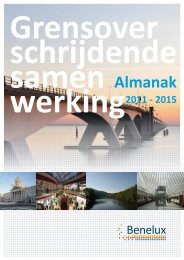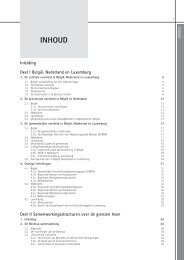The North Seas Countries' Offshore Grid Initiative - Initial ... - Benelux
The North Seas Countries' Offshore Grid Initiative - Initial ... - Benelux
The North Seas Countries' Offshore Grid Initiative - Initial ... - Benelux
Create successful ePaper yourself
Turn your PDF publications into a flip-book with our unique Google optimized e-Paper software.
Going forward, additional scenarios should be developed assessing each corner of the<br />
‘kite’ described in Figure 1-4. In the absence of agreed national/ Regional/ European<br />
2030 energy targets, these should be developed with key stakeholders. based, as far as<br />
possible, on common underlying assumptions<br />
6.1.3 <strong>Grid</strong> designs<br />
Under the grid expansion methodology special attention was given to the integration of<br />
offshore RES, but it also met the requirements under the other pillars of energy policy, as<br />
defined in the European Energy Infrastructure Package, i.e. Integration of Energy Markets<br />
(IEM), Implementation of Renewable Energy Resources (RES) and Security of Supply (SoS).<br />
An important finding of this study is that, under the Reference Scenario, further market<br />
integration is facilitated through the development of additional cross-border links. <strong>The</strong><br />
analysis also shows that it is essential to take the impact of offshore grid developments<br />
on the onshore network into account. <strong>The</strong>se impacts provide a critical element in the<br />
future grid designs.<br />
Two main offshore grid structures were considered:<br />
A radial design with offshore RES independently and radially connected to the<br />
onshore grid, separately from the establishment of point-to-point interconnectors<br />
An integrated (meshed) design where offshore RES and interconnectors can be<br />
connected to the onshore grid or to offshore hubs.<br />
Both designs provide access to all of the offshore wind parks assumed in the Reference<br />
scenario and therefore facilitate the renewable energy ambitions of the 10 Governments<br />
as set out in the Reference scenario.<br />
Because of the relatively small volumes of offshore RES expected between 2020 and 2030,<br />
there are limited opportunities for ‘meshing’ with only small differences between the costs<br />
(annuitised investment cost and annual VOM for the grid) and benefits (reduction in<br />
production costs, including CO impact and VOM for the generation) between the radial<br />
2<br />
and meshed designs. <strong>The</strong> results show an annual difference between radial and meshed of<br />
77 M€ p.a. in favour of a meshed approach. This difference may not necessarily be seen<br />
as significant enough to distinguish the results from a net break-even result for either<br />
design. Further investigation would be needed before taking project decisions based on<br />
these results.<br />
Any future offshore grid will not be built from blueprints or NSCOGI impressions for the<br />
future. It will be developed gradually based on robust business cases for individual<br />
projects <strong>The</strong> optimisation of candidate reinforcements does identify some opportunities<br />
for meshing in the reference scenario (in particular in the English Channel and between<br />
Belgium, the Netherlands and Great Britain). This is a contrast to other studies, e.g.<br />
[12],which found meshing opportunities for long-distance offshore assets – but used<br />
much higher offshore wind volumes (126 GW) than in the Reference Scenario (56 GW) as<br />
basis for the study, as further studies on future RES integration did [15] -[18], [21]; [23].<br />
Page 61 of 142










